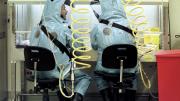Bird flu (H5N1) has receded from international headlines for the moment, as few human cases of the deadly virus have been reported this year. But when Dutch researchers recently created an even more transmissible strain of the virus in a laboratory for research purposes, they stirred grave concerns about what would happen if it escaped into the outside world. “Part of what makes H5N1 so deadly is that most people lack an immunity to it,” explains Marc Lipsitch, a professor of epidemiology at Harvard School of Public Health (HSPH) who studies the spread of infectious diseases. “If you make a strain that’s highly transmissible between humans, as the Dutch team did, it could be disastrous if it ever escaped the lab.”
H5N1 first made global news in early 1997 after claiming two dozen victims in Hong Kong. The virus normally occurs only in wild birds and farm-raised fowl, but in those isolated early cases, it made the leap from birds to humans. It then swept unimpeded through the bodies of its initial human victims, causing massive hemorrhages in the lungs and death in a matter of days. Fortunately, during the past 15 years, the virus has claimed only 400 victims worldwide—although the strain can jump species, it hasn’t had the ability to move easily from human to human, a critical limit to its spread.
That’s no longer the case, however. In late 2011, the Dutch researchers announced the creation of an H5N1 virus transmissible through the air between ferrets (the best animal model for studying the impact of disease on humans). The news caused a storm of controversy in the popular press and heated debate among scientists over the ethics of the work. For Lipsitch and many others, the creation of the new strain was cause for alarm. “H5N1 influenza is already one of the most deadly viruses in existence,” he says. “If you make [the virus] transmissible [between humans], you have to be very concerned about what the resulting strain could do.”
To put this danger in context, the 1918 “Spanish” flu—one of the most deadly influenza epidemics on record—killed between 50 million and 100 million people worldwide, or roughly 3 to 6 percent of those infected. The more lethal SARS virus (see “The SARS Scare,” March-April 2007, page 47) killed almost 10 percent of infected patients during a 2003 outbreak that reached 25 countries worldwide. H5N1 is much more dangerous, killing almost 60 percent of those who contract the illness.
If a transmissible strain of H5N1 escapes the lab, says Lipsitch, it could spark a global health catastrophe. “It could infect millions of people in the United States, and very likely more than a billion people globally, like most successful flu strains do,” he says. “This might be one of the worst viruses—perhaps the worst virus—in existence right now because it has both transmissibility and high virulence.”
Ironically, this is why Ron Fouchier, the Dutch virologist whose lab created the new H5N1 strain, argues that studying it in more depth is crucial. If the virus can be made transmissible in the lab, he reasons, it can also occur in nature—and researchers should have an opportunity to understand as much as possible about the strain before that happens.
Lipsitch, who directs the Center for Communicable Disease Dynamics at HSPH, thinks the risks far outweigh the rewards. Even in labs with the most stringent safety requirements, such as enclosed rubber “space suits” to isolate researchers, accidents do happen. A single unprotected breath could infect a researcher, who might unknowingly spread the virus beyond the confines of the lab.
In an effort to avoid this scenario, Lipsitch has been pushing for changes in research policy in the United States and abroad. (A yearlong, voluntary global ban on H5N1 research was lifted in many countries in January, and new rules governing such research in the United States were expected in February.) Lipsitch says that none of the current research proposals he has seen “would significantly improve our preparational response to a national pandemic of H5N1. The small risk of a very large public health disaster...is not worth taking [for] scientific knowledge without an immediate public health application.” His recent op-eds in scientific journals and the popular press have stressed the importance of regulating the transmissible strain and limiting work with the virus to only a handful of qualified labs. In addition, he argues, only technicians who have the right training and experience—and have been inoculated against the virus—should be allowed to handle it.
These are simple limitations that could drastically reduce the danger of the virus spreading, he asserts, yet they’re still not popular with some researchers. He acknowledges that limiting research is an unusual practice scientifically but argues, “These are unusual circumstances.”
Lipsitch thinks a great deal of useful research can still be done on the non-transmissible strain of the virus, which would provide valuable data without the risk of accidental release. In the meantime, he hopes to make more stringent H5N1 policies a priority for U.S. and foreign laboratories. Although it’s not a perfect solution, he says, it’s far better than a nightmare scenario.









